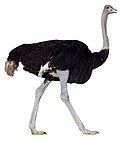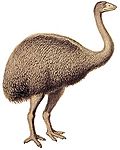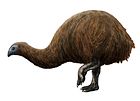| Upland moa Temporal range: Pleistocene-Holocene | |
|---|---|

| |
| Mounted skeleton from Honeycomb Hill Cave, collection of Te Papa | |
| Conservation status | |
 Extinct (c. 1500) (NZ TCS) | |
| Scientific classification | |
| Domain: | Eukaryota |
| Kingdom: | Animalia |
| Phylum: | Chordata |
| Class: | Aves |
| Infraclass: | Palaeognathae |
| Clade: | Notopalaeognathae |
| Order: | †Dinornithiformes |
| Family: | †Megalapterygidae Bunce et al., 2009 |
| Genus: | †Megalapteryx Haast 1886 |
| Species: | †M. didinus |
| Binomial name | |
| †Megalapteryx didinus (Owen, 1883) | |
| Synonyms | |
list
| |
The upland moa (Megalapteryx didinus) is an extinct species of moa that was endemic to New Zealand. The species was named by Richard Owen in 1883, and belongs to the ratites, a group of flightless birds with no keel on the sternum. Of all moa species, Megalapteryx didinus has the best-preserved specimens, which occasionally also show impressions of soft tissue. The upland moa lived on the South Island of New Zealand, and was predominantly found in alpine and sub-alpine environment where it fed on flowers, herbs and other vegetation. After the Māori arrived in New Zealand and started hunting it, the species went extinct around 1500 CE. It was the last remaining moa species.
Taxonomy
The upland moa was named as Dinornis didinus in 1883 by Richard Owen from mummified material found in 1878 by H. L. Squires in Queenstown, New Zealand and subsequently sent to the British Museum. The holotype specimen consists of a mummified head and partial neck, and two mummified legs and feet which preserve the feathers.
In 2005, a genetic study suggested that Megalapteryx benhami, which had previously been considered a junior synonym of M. didinus, may be a valid species after all.
The cladogram below follows a 2009 analysis by Bunce et al.:
| Dinornithiformes |
| ||||||||||||||||||||||||||||||||||||||||||||||||||||||
Description
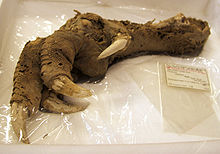
At less than 1 metre (3.3 ft) tall and about 17 to 34 kilograms (37 to 75 lb) in weight, the upland moa is among the smallest known moa species. Unlike other moas, it had feathers covering all of its body but the beak and the soles of its feet, an adaptation to living in cold environments. Scientists previously believed that the upland moa held its neck and head upright; however, more recent study has shown that it actually carried itself in a stooped posture, with its head level to its back. This would have helped it travel through the abundant vegetation present in its habitat, whereas an extended neck would have been more suited to open spaces. The upland moa had no wings or tail.
Soft tissue
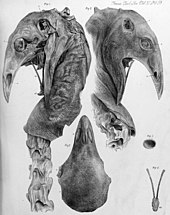
The species has the best-preserved mummified remains of any moa species. Several specimens with soft tissue and feather remains are known:
- British Museum A16, found at Queenstown in 1876, is the type of the species preserving a mummified head and partial neck along with two mummified partial hindlimbs.
- Otago Museum C.68.2A, leg with much muscle tissue, skin and feathers from the Old Man Range
- Museum of New Zealand Te Papa Tongarewa NMNZ S.000400, a skeleton with tissue on neck and head from the Cromwell area.
- MNZTPT NMNZ S.023080, a foot with some muscle and sinews, found on 7 January 1987 at Mount Owen. This was dated to be about 3,300–3,400 years old.
- MNZTPT NMNZ S.027950, feathers found in 1949 at Takahe Valley, Fiordland, New Zealand.
- Canterbury Museum NZ 1725, Remains of one partial egg which have been found at the Rakaia River in 1971 are tentatively attributed to this species. The radiocarbon date of approximately AD 1300–1400 is in line with this. Unusually, the eggshell is dark olive green, but even if the egg is of M. didinus, the shell colour may have varied between individual eggs.
- MNZTPT NMNZ S.023700, complete skeleton found by Trevor Worthy in March 1987 at Honeycomb Hill Cave, Oparara Valley
- Otago Museum AV10049, skeleton and partial egg found in 2002 at Serpentine Range, Humboldt Mountains.
Behavior and ecology
The upland moa was herbivorous, its diet extrapolated from fossilised stomach contents, droppings, and the structure of its beak and crop. It ate leaves and small twigs, using its beak to "shear with scissor-like moves". However, biomechanical testing of its beak and head has shown it was best suited to feed by pulling backwards, possibly while twisting its head to the side. Its food required grinding before it could be digested, as indicated by its large crop. Studies of the upland moa's coprolites have provided evidence that branchlets of trees such as Nothofagus, various lake-edge herbs, tussock, and nectar-rich flowers made up part of its diet. Based on the pollen present in the coprolites, it is suggested they had a similar lifestyle to the living takahē, feeding in high alpine areas during the summer and descending to lower altitude forests in the winter. They may also have played an important role in the seed dispersal of alpine plants.

This moa usually laid only 1 to 2 blue-green coloured eggs at once, and was likely the only type of moa to lay eggs that were not white in colour. Like the emu and ostrich, male moa cared for the young. The upland moa's only predator before the arrival of humans in New Zealand was the Haast's eagle (Hieraaetus moorei).
Distribution and habitat
The upland moa lived only on New Zealand's South Island, in mountains and sub-alpine regions. They travelled to elevations as high as 2000 m (7000 ft) above sea level.
Extinction
Humans first came in contact with the upland moa around 1250 to 1300 AD, when the Māori people arrived in New Zealand from Polynesia. Moa, being docile animals, were an easy source of food for the Māori (who called them "moa pukepuke"), and the birds were eventually hunted to extinction in 1445.
References
- ^ "Megalapteryx didinus. NZTCS". nztcs.org.nz. Retrieved 29 April 2023.
- ^ Brands, Sheila J. (1989). "The Taxonomicon". Zwaag, Netherlands: Universal Taxonomic Services. Retrieved 21 January 2010.
- Checklist Committee Ornithological Society of New Zealand (2010). "Checklist-of-Birds of New Zealand, Norfolk and Macquarie Islands and the Ross Dependency Antarctica" (PDF). Te Papa Press. Retrieved 4 January 2016.
- Owen, Richard (1883). "On Dinornis (Part XXIV): containing a Description of the Head and Feet, with their dried Integuments, of an Individual of the species Dinornis didinus, Owen". Transactions of the Zoological Society of London. 11 (8). London : Zoological Society of London: 257–261. Retrieved 7 July 2023.
- Baker, A. J.; Huynen, L. J.; Haddrath, O.; Millar, C. D.; Lambert, D. M. (2005). "Reconstructing the tempo and mode of evolution in an extinct clade of birds with ancient DNA: The giant moas of New Zealand". Proceedings of the National Academy of Sciences. 102 (23): 8257–62. Bibcode:2005PNAS..102.8257B. doi:10.1073/pnas.0409435102. PMC 1149408. PMID 15928096.
- Davies, S. J. J. F. (2003). "Moas". In Hutchins, Michael (ed.). Grzimek's Animal Life Encyclopedia. Vol. 8 Birds I Tinamous and Ratites to Hoatzins (2 ed.). Farmington Hills, MI: Gale Group. pp. 95–98. ISBN 978-0-7876-5784-0.
- Bunce, M.; Worthy, T. H.; Phillips, M. J.; Holdaway, R. N.; Willerslev, E.; Haile, J.; Shapiro, B.; Scofield, R. P.; Drummond, A.; Kamp, P. J. J.; Cooper, A. (2009). "The evolutionary history of the extinct ratite moa and New Zealand Neogene paleogeography" (PDF). Proceedings of the National Academy of Sciences. 106 (49): 20646–20651. Bibcode:2009PNAS..10620646B. doi:10.1073/pnas.0906660106. PMC 2791642. PMID 19923428.
- Vickers-Rich, P.; Trusler, P.; Rowley, M. J.; Cooper, A. (1 January 1995). "Morphology, myology, collagen and DNA of a mummified upland moa, Megalapteryx didinus (Aves: dinorthiformes) from New Zealand". Tuhinga: The Records of the Museum of New Zealand te Papa Tongarewa. 4: 1–26.
- ^ Flannery, Tim, "A Gap in Nature: Discovering the World's Extinct Animals", October 2001, ""
- ^ Museum of New Zealand, "Upland Moa", 1998, http://collections.tepapa.govt.nz/theme.aspx?irn=1348
- TerraNature, "Flightless Birds: Moa", http://terranature.org/moa.htm
- Tennyson, Alan J. D. (2006). Extinct birds of New Zealand. Paul Martinson. Wellington, N.Z.: Te Papa Press. p. 20. ISBN 978-0-909010-21-8. OCLC 80016906.
- Museum of New Zealand(a). "Megalapteryx didinus". Collections Online. Museum of New Zealand Te Papa Tongarewa. Retrieved 18 July 2010.
- Worthy, Trevor H. (1989). "Mummified moa remains from Mt Owen, northwest Nelson" (PDF). Notornis. 36 (1): 36–38. Archived from the original (PDF) on 27 October 2007. Retrieved 19 August 2006.
- Museum of New Zealand(b). "Megalapteryx didinus". Collections Online. Museum of New Zealand Te Papa Tongarewa. Retrieved 18 July 2010.
- McCulloch, Beverley (1992). "Unique, dark olive-green moa eggshell from Redcliffe Hill, Rakaia Gorge, Canterbury" (PDF). Notornis. 39 (1): 63–65. Archived from the original (PDF) on 18 October 2008. Retrieved 20 August 2006.
- Museum of New Zealand(c). "Megalapteryx didinus". Collections Online. Museum of New Zealand Te Papa Tongarewa. Retrieved 18 July 2010.
- "THE HUNT IS ON: Upland Moa Recovery Project".
- Attard, Marie R. G.; Wilson, Laura A. B.; Worthy, Trevor H.; Scofield, Paul; Johnston, Peter; Parr, William C. H.; Wroe, Stephen (2016). "Moa diet fits the bill: virtual reconstruction incorporating mummified remains and prediction of biomechanical performance in avian giants". Proceedings of the Royal Society B: Biological Sciences. 283 (1822): 20152043. doi:10.1098/rspb.2015.2043. PMC 4721086. PMID 26763698. Retrieved 21 July 2023.
- Horrocks, Mark; D'Costa, Donna; Wallace, Rod; Gardner, Rhys; Kondo, Renzo (2004). "Plant remains in coprolites: diet of a subalpine moa (Dinornithiformes) from southern New Zealand". Emu – Austral Ornithology. 104 (2): 149–156. Bibcode:2004EmuAO.104..149H. doi:10.1071/MU03019. S2CID 86345660.
- ^ Wood, Jamie R.; Wilmshurst, Janet M.; Wagstaff, Steven J.; Worthy, Trevor H.; Rawlence, Nicolas J.; Cooper, Alan (2012). "High-Resolution Coproecology: Using Coprolites to Reconstruct the Habits and Habitats of New Zealand's Extinct Upland Moa (Megalapteryx didinus)". PLOS ONE. 7 (6): e40025. Bibcode:2012PLoSO...740025W. doi:10.1371/journal.pone.0040025. PMC 3386916. PMID 22768206. Retrieved 21 July 2023.
- Igic, Branislav; Greenwood, David R.; Palmer, David J.; Cassey, Phillip; Gill, Brian J.; Grim, Tomas; Brennan, Patricia L. R.; Bassett, Suzanne M.; Battley, Phil F.; Hauber, Mark E. (2010). "Detecting pigments from colourful eggshells of extinct birds". Chemoecology. 20 (1): 43–48. Bibcode:2010Checo..20...43I. doi:10.1007/s00049-009-0038-2. S2CID 10956718.
- Gill, B. J. (2006). "A Catalogue of Moa Eggs (Aves: Dinornithiformes)". Papahou: Records of the Auckland Museum. 43: 55–80. ISSN 1174-9202. JSTOR 42905885. Wikidata Q58623352.
- Tennyson, Alan J. D. (2006). Extinct birds of New Zealand. Paul Martinson. Wellington, N.Z.: Te Papa Press. ISBN 978-0-909010-21-8. OCLC 80016906.
- Worthy, Trevor H.'Moa – Moa and people', Te Ara – the Encyclopedia of New Zealand, updated 13-Jul-12 URL: http://www.TeAra.govt.nz/en/moa/page-4
External links
 Media related to Megalapteryx didinus at Wikimedia Commons
Media related to Megalapteryx didinus at Wikimedia Commons Data related to Megalapteryx didinus at Wikispecies
Data related to Megalapteryx didinus at Wikispecies- Upland Moa. Megalapteryx didinus. by Paul Martinson. Artwork produced for the book Extinct Birds of New Zealand by Alan Tennyson, Te Papa Press, Wellington, 2006
- Articulated skeleton at the Museum of New Zealand Te Papa Tongarewa
- Articulated Upland moa skeleton at the Otago Museum
| Taxon identifiers | |
|---|---|
| Megalapteryx didinus | |
